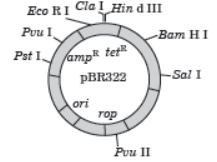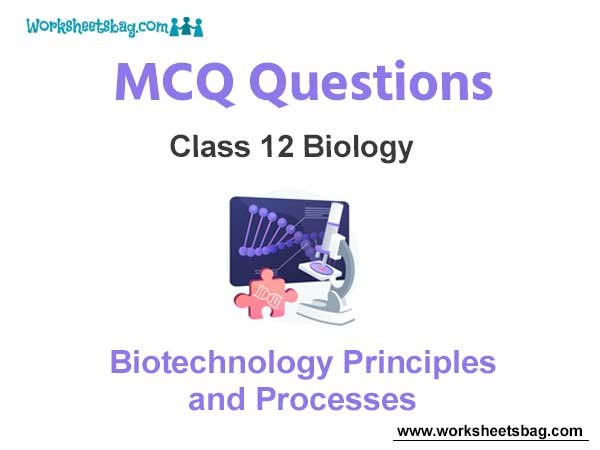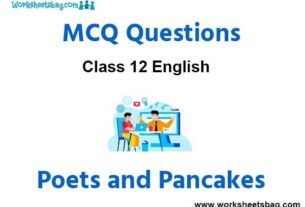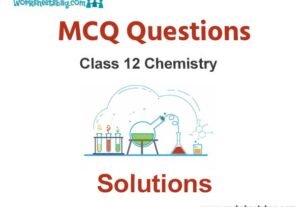Please refer to Biotechnology Principles and Processes MCQ Questions Class 12 Biology below. These MCQ questions for Class 12 Biology with answers have been designed as per the latest NCERT, CBSE books, and syllabus issued for the current academic year. These objective questions for Biotechnology Principles and Processes will help you to prepare for the exams and get more marks.
Biotechnology Principles and Processes MCQ Questions Class 12 Biology
Please see solved MCQ Questions for Biotechnology Principles and Processes in Class 12 Biology. All questions and answers have been prepared by expert faculty of standard 12 based on the latest examination guidelines.
MCQ Questions Class 12 Biology Biotechnology Principles and Processes
Question- Most suitable method of introducing alien DNA into a plant cell is
(a) lipofection
(b) biolistics
(c) heat shock method
(d) microinjection.
Answer
B
Question- Restriction endonucleases are
(a) used for in vitro DNA synthesis
(b) synthesised by bacteria as part of their defence mechanism
(c) present in mammalian cells for degradation of DNA when the cell dies
(d) used in genetic engineering for ligating two DNA molecules.
Answer
B
Question- Select the wrong statement.
(a) The presence of chromogenic substrate gives blue colour colonies, if the plasmid in the bacteria does not have an insert.
(b) Retroviruses in animals have the ability to transform normal cells into cancerous cells.
(c) In microinjection, cells are bombarded with high velocity microparticles of gold or tungsten coated with DNA.
(d) Since DNA is a hydrophilic molecule it cannot pass through cell membranes.
Answer
C
Question- Identify the DNA segment which is not a palindromic sequence.
(a) 5′ GGATCC 3′ 3′ CTTAAG 5′
(b) 5′ GAATTC 3′3′ GGTACC 5′
(c) 5′ GCGGCCGC 3′ 3′ CGCCGGCG 5′
(d) 5′ CCCGGG 3′ 3′ 3′ GGGCCC 5′
Answer
A
Question- The given figure is the diagrammatic representation of the E. coli vector pBR 322.
Which one of the given options correctly identifies its certain component(s)?

(a) ori-original restriction enzyme
(b) rop-reduced osmotic pressure
(c) HindIII, EcoRI – selectable markers
(d) ampR, tetR–antibiotic resistance genes
Answer
D
Question- The controlled use of biological agents, such as microorganisms or cellular components, for beneficial use is called
(a) plant biology
(b) biochemistry
(c) biotechnology
(d) molecular biology
Answer
C
Question- PCR needs-
(a) 2 sets of primers
(b) Taq polymerase
(c) Nucleotide as raw materials
(d) All
Answer
A
Question-The experimental manipulation of DMA of different species, producing recombinant DMA is known as
(a) electroporesis
(b) recombinant DMA technology
(c) transformation
(d) somatic hybridization
Answer
B
Question- Restriction enzymes are used in genetic engineering because:
(a) They can cut DMA at specific base sequence
(b) They are nuclease that can cut DMA at variable sites
(c) They can join different DMA fragments
(d) They are proteolytic enzymes which can degrade harmful proteins
Answer
A
Question- During isolation of DMA, addition of which of the following causes precipitation of purified DMA?
(a) Chilled ethanol
(b) Ribonuclease enzyme
(c) DMA polymerase
(d) Proteases
Answer
A
Question- Which of the following is not applicable to Agrobacterium tumifaciens?
(a) Pathogen of several dicot plants
(b) Has ability to transform normal plant cells
(c) Delivers gene of our interest
(d) Ti plasmid of it is always pathogenic to plants without any exception
Answer
D
Question- Molecular scissors which cut DNA at specific site in-
(a) Pectinase
(b) Polymerase
(c) Restriction Endonudease
(d) Liganc
Answer
C
Question- Plasmids are-
(a) DNA
(b) Mitochondrial DNA
(c) Circular extra chromosomal DNA bacteria
(d) viral RNA
Answer
C
Question- Identify the plasmid-
(a) Eco RI
(b) pBR322
(c) AlUl
(d) Hind II
Answer
B
Question- The structure involved in genetic engineering is:
(a) Plasmid
(b) Plastid
(c) Codon
(d) Anticodon
Answer
A
Question- Process by which we can add or delete certain gene is :
(a) Gene therapy
(b) Biotechnology
(c) Genetic engineering
(d) Cytogenetics
Answer
C
Question- Plasmid present in bacterial cells are :
(a) Circular double helical DMA molecules
(b) Linear double helical DMA molecules
(c) Circular double helical RNA molecules
Answer
A
Question- A bioreactor (fermenter) refers to
(a) a device in which substances are treated to stimulate biochemical-transformation by living cells
(b) a nuclear reactor for biological studies
(c) a tank for biochemical reactions
(d) organisms reacting to a stimulus
Answer
A
Question- Which is being synthesized by genetic engineering :
(a) Insulin
(b) Renin
(c) Thyroxine
(d) Progesterone
Answer
A
Question- DMA finger printing is based on :
(a) Clones of DMA
(b) DMA segments formed by RE enzymes
(c) Human efforts
(d) Gene library
Answer
A
Question- What must be done before placing DNA into the electrophoretic chamber?
(a) It must be ground up with mortar and pestle
(b) It must be cut by restriction endonucleases
(c) It must be treated with RNAase
(d) None
Answer
B
Question- In DNA fingerprinting:
(a) The variability of repeated sequences between two restriction sites is evaluated.
(b) Exonuclease enzyme digests/generate unique fragments
(c) Amplifies fewer DNA
(d) Protein is identified
Answer
A
Question- Transgenic plants are developed by-
(a) Clone and genetically modified genes
(b) Introduction of foreign geres
(c) Genetic engineering
(d) Purified genes
Answer
B
Question- Fill up the blanks –
A. The construction of the first recombinant DNA emerged from the possibility of linking a gene encoding antibiotic resistance with a native _____ of_____.
B. Hind II always cut DNA molecules at a particular point by recognising a specific sequence of ______ base pairs. This specific sequence is known as ______for Hind II.
C. The ______ in DNA is a sequence of base that reads same on the two strands when orientation of reading is kept the same.
D. ______, a pathogen of several dicot plants is able to deliver a piece of DNA known as ______to transform normal plant cells into tumor cells.
(a) A – Plasmid, Salmonella typhimurium; B – Six, Recognition sequence, C – P ndrome, D – Agrobacterium tumifaciens, T-DNA
(b) A- Plasmid, Salmonella typhimurium; B – Seven, Recognition sequence, C – P ndrome, D – Agrobacterium tumifaciens, T-DNA
(c) A- Chromosome, Salmonella typhimurium; B – Six, Recognition sequence, G – P ndrome, D-Agrobacterium tumifaciens, T-DNA
(d) A – Plasmid, Salmonella typhimurium; B – Six, Recognition sequence, C – P ndrome, D – Agrobacterium tumifaciens, Z-DNA
Answer
A
Question- Identify the true statements –
A. The first recombinant DNA was constructed by using a piece of DNA from a plasmid carrying antibiotic resistance gene in the bacterium Salmonella typhimurium and linked it to the plasmid of E. coll.
B. Cohen and Boyer are known as father of genetic engineering.
C. When cut by the same restriction enzyme, the resultant DNA fragments have the same kind of sticky ends and these can be joined together using DNA \-times.
D. Endonucleases remove nucleotides from the ends of the DNA whereas exonucleases make cuts at specific positions within the DNA.
E. Presence of more than one recognition sites within the vector will generate several fragments, which will complicate the gene cloning.
F. Humulin was the first recombinant DNA, based product, produced and marketed in India.
G. YAC vectors contain the telomeric sequence, the centromere and autonomously replicating sequence from yeast chromosomes.
H. Alk ne phosphatase, is used to- prevent unwanted self ligation of the vector DNA molecules in procedures of r DNAtechnology.
I. pBR322 vector was the first artificial ideal vector constructed by Boliver and Rodriguer.
J. Plasmid DNA is coated with histone proteins and can act as genetic factor.
(a) B, D, F, J
(b) B, D, E, J
(c) A, C, E, G, H, I
(d) A, B, D, F, J
Answer
C
Question- During gel electrophoresis for separation of DMA fragment
(a) Smallest fragment will move to the farthest point towards cathode
(b) Smallest fragment will move to the farthest point towards anode
(c) Largest fragment will move to the farthest point towards cathode
(d) Largest fragment will move to the farthest point towards anode
Answer
B
Question-After completing the transformation experiment involving the coding sequence of enzyme a-galactosidase, the recombinant colonies should
(a) Give blue colour
(b) Not give blue colour
(c) Have active a -galactosidase
(d) Both (b) & (c)
Answer
B
Question- Column I Column II
| I. Ti plasmid | A. Agrobacterium tumifaciens |
| II. Sail | B. Cancerous cells |
| III. Retroviruses | C. Recombinant DNA |
| IV. Ligase | D. Restriction enzyme |
(a) l-D, II-A, III-B, IV-C
(b) I-B., II-A, III-D, IV-C
(c) l-D, II-A, ill-C, IV-B
(d) l-B, II-A, III-D, IV-C
Answer
D
Question- Which of the following enzyme is used in case of fungus to cause release of DMA along with other macromolecules?
(a) Lysozyme
(b) Cellulase
(c) Chitinase
(d) Amylase
Answer
C
Question- DNA fingerprinting is done by a technique called:
(a) ELISA
(b) Northern blotting
(c) Southern blotting
(d) RIA
Answer
C
Question- The construction of the first recombinant DNA was done by using the native plasmid of-
(a) E. Coli
(b) Salmonella typhimurium
(c) B.Thuringiensis
(d) Yeast
Answer
B
Question- When gerotype of an organism is improved by the addition of foreign genes the process sin called-
(a) Biotechnology
(b) Tissue culture
(c) Genetic engineering
(d) Genetic diversity
Answer
C
Question- Column I Column II
| I. Cloning | A. Making multiple identical copies |
| II. Molecular scissor | B. Tumour |
| !!!. Restriction endonuclease | C. Restriction enzymes |
| IV. T-DNA | D. Enzyme |
(a) I -D, II-A, III-B, IV-C
(b) l-B, II-A, III-D, IV-C
(c) l-A,ll-C, III-D, IV-B
(d) l-A, II-D, III-B, IV-C
Answer
C
Question- Restriction endonucleases-
A. are found in bacteria
B. are very useful in genetic engineering
C. cut the DMA at particular sites
D. are used naturally in a bacterial cell to defend against foreign DMA
(a) A,B
(b) B,C
(c) C,D
(d) A,B, C, D
Answer
D
Question- During heat shock to the bacterium, the temperature used for giving thermal shock is
(a) 82°C
(b) 100°C
(c) Liquid nitrogen
(d) 42°C
Answer
D
Question- After the formation of the product in the bioreactors, it undergoes through separation and purification process before a finished product is ready for marketing. These processes are collectively referred to as
(a) upstream processing
(b) downstream processing
(c) elution
(d) transformation
Answer
B
Question- Which of the following techniques can be used to introduce foreign DNA into cell?
(a) Using disarmed pathogen
(b) Microinjection
(c) Gene gun
(d) All of these
Answer
D
Question- For transformation with recombinant DNA, the bacterial cells must first be made ‘competent’ which means
(a) Should increase their metabolic reactions
(b) Should decrease their metabolic reactions
(c) Increase efficiency with which DNA enters the bacterium
(d) Ability to divide fast
Answer
C
Question- Which steps are involved in genetically modifying an organism?
A Identification of desirable DNA B. Insertion of DNA into the host
C. Maintenance of introduced DNA in the host D. Isolation of recombinant protein
(a) A, B
(b) B, C
(c) A, B, C
(d) A,B,C,D
Answer
C
Question- Which of the following has the ability to transform normal cells into cancerous cells in animals?
(a) Agrobacterium tumefaciens
(b) Retroviruses
(c) DNA-viruses
(d) Plasmids
Answer
B
Question- The areas of application of PCR include
A. production of monoclonal antibodies B. insertion of recombinant DNA into organism
C. diagnosis of specific mutation D. detection of plant pathogens.
(a) A, B
(b) B,C
(c) C, D
(d) A, B, C, D
Answer
C
Question- The term humulin is associated with :
(a) Insulin hormone produced by transgenic E.co
(b) Lysosomal enzyme
(c) Isoenzymes of LDH
(d) Antibiotic produced by transgenic Penicillium
Answer
A
Question- The most commonly used bioreactor is of stirring type. The stirrer facilitates
(a) Temperature control
(b) pH control
(c) Oxygen availability
(d) Product removal
Answer
C
Question- Which enzymes are used to break the cell to release DMA?
(a) Lysozyme
(b) Cellulase
(c) Chitinase
(d) AII of these
Answer
D
Question-. Which one is associated with Agrobacterium tumifaciens?
A. Tumor B. Ti plasmid C. T-DNA D. Cancerous cells
(a) A, B
(b) B,C
(c) A, B, C
(d) A,B, C, D
Answer
B
Question- The first restriction endonuclease reported was
(a) Hind II
(b) EcoRI
(c) Hind III
(d) BamHI
Answer
A
Question- Insertional inactivation is related to
(a) Microinjection
(b) Gene gun
(c) Gel electrophoresis
(d) Selection of recombinants
Answer
D
Question- Pairing of fragments derived from DNA is a process called
(a) Staggering
(b) Anne ng
(c) Augmenting
(d) Fragmenting
Answer
B
Question- Cay endo borins obtained from Bacillum thuriagemiss are effective against
(a) Nenatodes
(b) Boll worms
(c) Mosquitoes
(d) Flies
Answer
B
Question- Which of the following method(s) is/are used to introduce foreign DNA into host cells?
(a) biolistics
(b) electrophoresis
(c) elution
(d) DNA ligation
Answer
A
Question- Which of the following method can be used for making the bacterial cell ‘competent’?
(a) Treating with specific cone, of divalent cation (Ca2+)
(b) Treating with specific cone, of monovalent cation (K+)
(c) Heat shock
(d) Both (a) & (c)
Answer
D
Question- The tumour-inducing capacity of Agrobacterium tumifaciens is located in large extrachromosomal plasmids called
(a) Ri plasmids
(b) plasmid pBR 322
(c) lamb: phage
(d) Tiplasmid
Answer
D
Question- Molecular probes used for identification of recombinant clone carrying the desired DNA insert can be
A. denatured double stranded DNA probes B double stranded RNA probes
C. protein probes D. single stranded DNA probes
(a) A, B
(b) B, C
(c) A, D
(d) A, B, C, D
Answer
A
Question- X technique is now routinely used to detect HIV in suspected AIDS patients. It is being used to detect mutations in genes in suspected cancer patients too. It is a powerful technique to identify many other genetic disorders. Identify X-
(a) X = PCR
(b) X = DMA fingerprinting
(c) X = Bioinformatic
(d) X = X-ray defraction
Answer
A
Question. The process of separation and purification of expressed protein before marketing is called
(a) downstream processing
(b) bioprocessing
(c) postproduction processing
(d) upstream processing.
Answer
A
Question. Select the wrong statement.
(a) The presence of chromogenic substrate gives blue colour colonies, if the plasmid in the bacteria does not have an insert.
(b) Retroviruses in animals have the ability to transform normal cells into cancerous cells.
(c) In microinjection, cells are bombarded with high velocity microparticles of gold or tungsten coated with DNA.
(d) Since DNA is a hydrophilic molecule it cannot pass through cell membranes.
Answer
C
Question. Which of the following is a restriction endonuclease?
(a) DNaseI
(b) RNase
(c) HindII
(d) Protease
Answer
C
Question. Which vector can clone only a small fragment of DNA?
(a) Bacterial artificial chromosome
(b) Yeast artificial chromosome
(c) Plasmid
(d) Cosmid
Answer
C
Question. DNA into a plant cell is
(a) lipofection
(b) biolistics
(c) heat shock method
(d) microinjection.
Answer
B
Question. The colonies of recombinant bacteria appear white in contrast to blue colonies of nonrecombinant bacteria because of
(a) i n s e r t i o n a l i n a c t i v a t i o n o f a l p h a galactosidase in recombinant bacteria
(b) inactivation of glycosidase enzyme in recombinant bacteria
(c) non-recombinant bacteria containing beta galactosidase
(d) i n s e r t i o n a l i n a c t i v a t i o n o f a l p h a galactosidase in non-recombinant bacteria.
Answer
C
Question. PCR and restriction fragment length polymorphism are the methods for
(a) study of enzymes
(b) genetic transformation
(c) DNA sequencing
(d) genetic fingerprinting.
Answer
D
Question. The given figure is the diagrammatic representation of the E. coli vector pBR 322.
Which one of the given options correctly identifies its certain component(s)?

(a) ori-original restriction enzyme
(b) rop-reduced osmotic pressure
(c) HindIII, EcoRI – selectable markers
(d) ampR, tetR–antibiotic resistance genes
Answer
D
Question. A selectable marker is used to
(a) help in eliminating the non-transformants, so that the transformants can be regenerated.
(b) identify the gene for a desired trait in an alien organism.
(c) select a suitable vector for transformation in a specific crop.
(d) mark a gene on a chromosome for isolation using restriction enzyme.
Answer
A
Question. For transformation, micro-particles coated with DNA to be bombarded with gene gun are made up of
(a) silver or platinum
(b) platinum or zinc
(c) silicon or platinum
(d) gold or tungsten.
Answer
D
Question. The term, ‘Southern Blotting’ refers to
(a) transfer of DNA fragments from in vitro cellulose membrane to electrophoretic gel
(b) attachment of probes to DNA fragments
(c) t r a n s f e r o f DNA fragments from electrophoretic gel to nitrocellulose sheet
(d) comparison of DNA fragments from two sources.
Answer
C
Question. Given below is a sample of a portion of DNA strand giving the base sequence on the opposite strands. What is so special shown in it?
5′_____ GAATTC′ _____ 3′
3′_____ CTTAAG _____ 5′
(a) Replication completed
(b) Deletion mutation
(c) Start codon at the 5′ end
(d) Palindromic sequence of base pairs.
Answer
D



